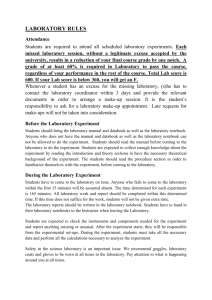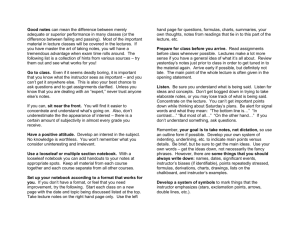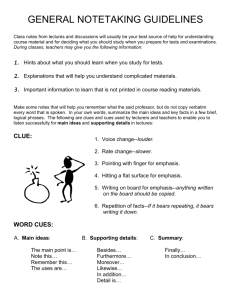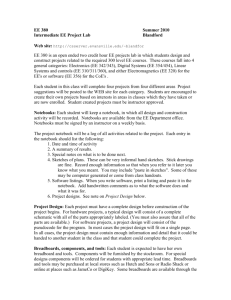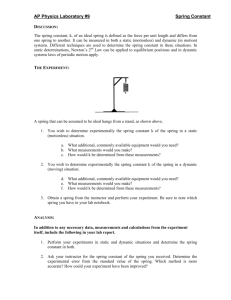Syllabus and Schedule - Electrical and Computer Engineering at the
advertisement
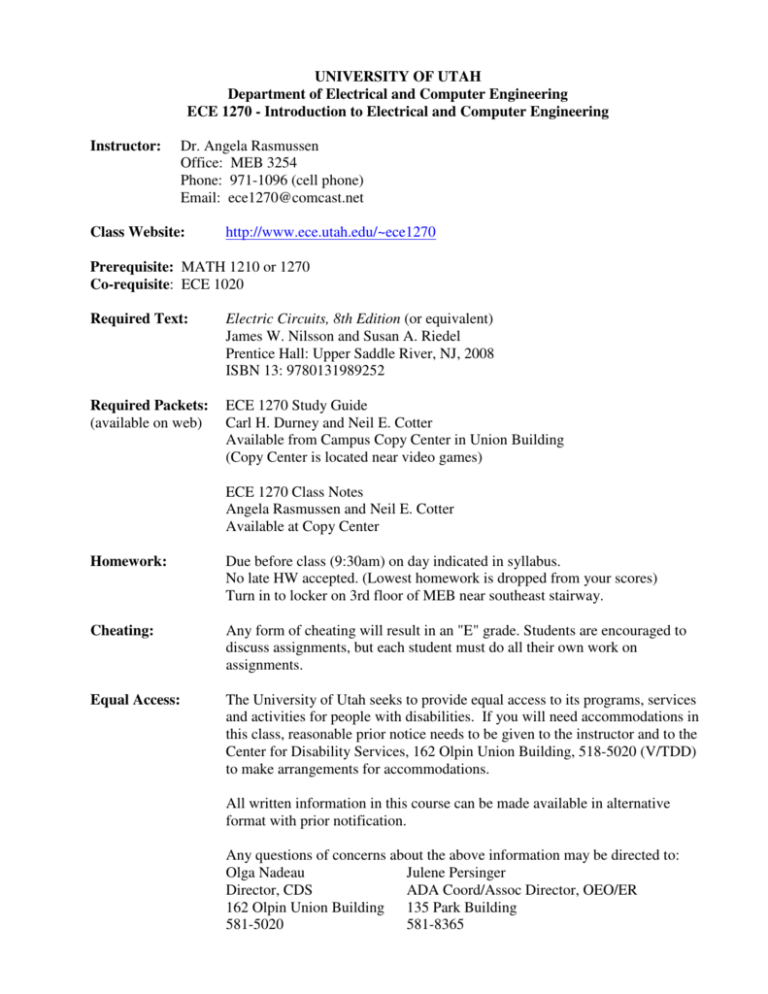
UNIVERSITY OF UTAH Department of Electrical and Computer Engineering ECE 1270 - Introduction to Electrical and Computer Engineering Instructor: Dr. Angela Rasmussen Office: MEB 3254 Phone: 971-1096 (cell phone) Email: ece1270@comcast.net Class Website: http://www.ece.utah.edu/~ece1270 Prerequisite: MATH 1210 or 1270 Co-requisite: ECE 1020 Required Text: Electric Circuits, 8th Edition (or equivalent) James W. Nilsson and Susan A. Riedel Prentice Hall: Upper Saddle River, NJ, 2008 ISBN 13: 9780131989252 Required Packets: (available on web) ECE 1270 Study Guide Carl H. Durney and Neil E. Cotter Available from Campus Copy Center in Union Building (Copy Center is located near video games) ECE 1270 Class Notes Angela Rasmussen and Neil E. Cotter Available at Copy Center Homework: Due before class (9:30am) on day indicated in syllabus. No late HW accepted. (Lowest homework is dropped from your scores) Turn in to locker on 3rd floor of MEB near southeast stairway. Cheating: Any form of cheating will result in an "E" grade. Students are encouraged to discuss assignments, but each student must do all their own work on assignments. Equal Access: The University of Utah seeks to provide equal access to its programs, services and activities for people with disabilities. If you will need accommodations in this class, reasonable prior notice needs to be given to the instructor and to the Center for Disability Services, 162 Olpin Union Building, 518-5020 (V/TDD) to make arrangements for accommodations. All written information in this course can be made available in alternative format with prior notification. Any questions of concerns about the above information may be directed to: Olga Nadeau Julene Persinger Director, CDS ADA Coord/Assoc Director, OEO/ER 162 Olpin Union Building 135 Park Building 581-5020 581-8365 UNIVERSITY OF UTAH ELECTRICAL AND COMPUTER ENGINEERING DEPARTMENT Tentative Schedule ECE 1270 Due T Date 18 May R 20 HW1 T 25 HW2 R Summer 2009 Reading Ch. 1 (Summary pg. 16) Ch. 2 (Summary pg. 47) 27 Topics Course Procedures, Intro, Basic DC Circuits: Units, Voltage v, Current i, Power p, EM simp., Devices, Passive Sign Convention, Sourcesvoltage, current, independent and dependent, Kirchoff’s Laws, Ohm’s Law Lab0 starts Circuits: Resistor Networks (parallel/series), voltage and current dividers, power dissipation, Op Amps Op-Amps - ideal amplifier Lab 1 starts Review T 1 June EXAM 1, Node Voltage Method, Mesh Current Method Ch. 4 (4.1-4.11) HW3 R T 3 8 Thevenin Equivalent – Thevenin and Norton transforms Examples Lab1 ends HW4 R 10 Examples and Review T 15 Exam 2 Lab 2 starts R 17 T 22 RLC Circuits: C(Capacitor Equations), L (Inductor Equations), General Solution RLC Circuits: C(Capacitor Equations), L (Inductor Equations), General Solution (Cont.) R 24 Examples HW5 T 29 Maximum Power Transfer, Superposition Lab 2 ends HW6 R 1 July Review T 6 R 8 T 13 Exam 3 Lab 3 starts Complex Analysis – Basic Math (properties of complex number, rationalization, add, subtract) Complex Analysis - Impedance, Phasors, Ohms Law Impedance Circuits – Kirchoff’s Laws, Node-Voltage Ch. 3 (3.1-3.4) Ch. 5 (5.1-5.2) Op Amps Ch. 6 (6.1.6.3) (Summary pg. 217) Ch. 7 (7.1-7.4) Ch. 9 Method, Thevenin Equivalent R 15 Impedance Circuits – Superposition HW7 T 20 Review HW8 R 22 T 27 Review Lab 3 ends EXAM 4 R 29 Comprehensive Review T 3 Aug Comprehensive Review HW9 &10 Final: Friday, August 6, 7:30-9:30 AM Sections 4.12, 4.13 Text Reading and Example Problems with Answers (8th edition) Unit 1: Ch. 1 Units, Voltage, Current, Power, Passive Sign Convention (Summary pg. 17) Ch. 2 Analysis of circuits - Dependent sources, power, Kirchhoff’s Law’s, Ohm’s Law (Summary pg. 47) Assessments: (pg. 28, 32, 42, 46) 2.1-2.5, 2.8-2.10 Back of Chapter Problems: (pg. 48-53) Pr. 2.2-2.3, 2.6, 2.8, 2.14, 2.17-2.19, 2.24, 2.28 Ch. 3 (3.1-3.4) Resistors in parallel and series, Voltage Divider, Current Divider Assessments: (pg. 62, 65, 67) 3.1-3.4 Back of Chapter Problems: (pg. 80-84) Pr. 3.1, 3.2, 3.5, 3.6, 3.13, 3.15, 3.21-3.23 Ch. 5 (5.1-5.2) Op Amps Assessments: (pg. 161) 5.1 Back of Chapter Problems: (pg. 176) Pr. 5.1-5.3 Examples: 2.1, 2.2, 2.6-2.8, 2.10-2.11, 3.1-3.4 Unit 2: Ch. 4 (4.1-4.11) Definitions, Node Voltage, Supernode, Mesh current, Supermesh, Thevenin Equivalent Assessments: (pg. 99-101, 104. 107, 109, 112, 116, 123, 125) 4.1-4.14, 4.16, 4.18-4.20 Back of Chapter Problems: (pg. 139-149) Pr. 4.6, 4.9, 4.10, 4.12, 4.13, 4.19-4.21, 4.26, 4.27, 4.31, 4.32, 4.37, 4.38, 4.41, 4.42, 4.47, 4.50, 4.54-4.56, 4.63, 4.67a, 4.71, 4.77 Examples: 4.1-4.3, 4.4-4.7, 4.10, 4.11 Unit 3: Ch. 6 (6.1.6.3) – Inductors, Capacitors (Summary pg. 217) Ch. 7 (7.1-7.4) - 1st order response, RL switch, RC switch, General Solution Assessments: (pg. 195, 199, 203, 236, 240, 245, 248) 6.1-6.5, 7.1(a-d), 7.2a, 7.3(a-d), 7.4-7.6 Back of Chapter Problems: (pg. 218, 220-222, 265-273) Pr. 6.1, 6.3, 6.14, 6.15, 6.21, 6.22, 6.26, 6.27, 7.1(a-c), 7.2, 7.3, 7.21, 7.24, 7.33-7.35, 7.50, 7.51 Sections 4.12, 4.13 Maximum Power Transfer, Superposition Assessments: (pg. 129) 4.12-4.22 Back of Chapter Problems: (pg. 149) Pr. 4.79, 4.80 Examples: 7.1-7.3, 7.4-7.6, 7.7-7.9, 4.12, 4.13 Unit 4: Ch. 9 Complex Numbers, Sinusoidal Signals, Phasors, Frequency Domain Analysis Assessments: (pg. 342, 346, 348, 349, 352, 358, 360, 361) 9.1-9.8, 9.11-9.13 Back of Chapter Problems: (pg. 377-384) Pr. 9.12, 9.13, 9.15-9.16, 9.21, 9.26-9.28, 9.51, 9.56, 9.58, 9.61 Examples: 9.1-9.3, 9.5b, 9.6, 9.7, 9.10-9.12, 9.15 Text Reading and Example Problems with Answers (9th edition) Unit 1: Ch. 1 Units, Voltage, Current, Power, Passive Sign Convention (Summary pg. 18) Ch. 2 Analysis of circuits - Dependent sources, power, Kirchhoff’s Law’s, Ohm’s Law (Summary pg. 47) Assessments: (pg. 30, 33, 42, 46) 2.1-2.5, 2.8-2.10 Back of Chapter Problems: (pg. 48-53) Pr. 2.2, 2.4, 2.5, 2.7, 2.11, 2.13, 2.14, 2.17, 2.18, 2.19, 2.22, 2.28 Ch. 3 (3.1-3.4) Resistors in parallel and series, Voltage Divider, Current Divider Assessments: (pg. 61, 64, 66) 3.1-3.4 Back of Chapter Problems: (pg. 77-87) Pr. 3.1, 3.2, 3.3, 3.4, 3.15, 3.16, 3.18, 3.23, 3.24 Ch. 5 (5.1-5.2) Op Amps Assessments: (pg. 150, 152) 5.1, 5.2 Back of Chapter Problems: (pg. 165-168) Pr. 5.1-5.3, 5.9, 5.11, 5.18, 5.26 Examples: 2.1-2.3, 2.5-2.11, 3.1-3.4 Unit 2: Ch. 4 (4.1-4.11) Definitions, Node Voltage, Supernode, Mesh current, Supermesh, Thevenin Equivalent Assessments: (pg. 95, 96, 99, 102, 103, 106, 109, 117, 119) 4.1-4.14, 4.16, 4.19-4.20 Back of Chapter Problems: (pg. 130-149) Pr. 4.1-4.4, 4.8, 4.9, 4.13, 4.17, 4.19, 4.24, 4.26, 4.27, 4.33, 4.34, 4.38, 4.39, 4.42, 4.44, 4.48, 4.51, 4.52, 4.53, 4.63, 4.71a, 4.74, 4.77 Examples: 4.1--4.7, 4.10, 4.11 Unit 3: Ch. 6 (6.1.6.3) – Inductors, Capacitors (Summary pg. 203) Ch. 7 (7.1-7.4) - 1st order response, RL switch, RC switch, General Solution Assessments: (pg. 182, 186, 189, 220, 224, 228, 231) 6.1-6.5, 7.1(a-d), 7.2a, 7.3(a-d), 7.4-7.6 Back of Chapter Problems: (pg. 204-209, 247-256) Pr. 6.1, 6.4, 6.16, 6.17, 6.21, 6.25, 6.26, 6.31, 7.4, 7.5, 7.7(a-c), 7.23, 7.26, 7.35, 7.36, 7.37, 7.51, 7.53, 7.55, 7.56 Sections 4.12, 4.13 Maximum Power Transfer, Superposition Assessments: (pg. 122) 4.21-4.22 Back of Chapter Problems: (pg. 140-143) Pr. 4.83, 4.87, 4.91, 4.96, 4.105, 4.106, 4.107 Examples: 7.1-7.9, 4.12, 4.13 Unit 4: Ch. 9 Complex Numbers, Sinusoidal Signals, Phasors, Frequency Domain Analysis(Summary 347) Assessments: (pg. 317, 320, 322, 323, 326, 332, 333, 334) 9.1-9.8, 9.11-9.13 Back of Chapter Problems: (pg. 377-384) Pr. 9.1, 9.4, 9.9, 9.11, 9.13, 9.14, 9.15, 9.24, 9.28, 9.29, 9.32, 9.37, 9.55, 9.59, 9.60, 9.64, 9.84, 9.85, 9.88, 9.89 Examples: 9.1-9.3, 9.5b, 9.6, 9.7, 9.10-9.12, 9.15, 9.16 Course Procedure ECE1270 The learning system used in ECE 1270 has been designed on the basis of the principles of learning1-3. I won't give you a lengthy description of those principles here, but let me state informally two of them that are very important for you to understand because they should guide your work in this course. 1. You learn what you practice and only what you practice. 2. In order to learn, you must obtain feedback about your work. The first principle is extremely important to you because it tells you that you must practice to learn. You actually learn very little while you are just listening to an instructor, although you may be stimulated and you may get ideas and some information. If you question this statement, test it by listening very carefully to a lecture in which the instructor derives a relation or works out a problem. Then try to do the same derivation or work the same problem without looking at your notes. You will find that you have to do it yourself to learn it. Your learning actually occurs as you practice, that is, as you answer questions, solve problems, design circuits, explain behavior, hook up circuits, measure voltages, measure currents, test devices, plot graphs, take exams, write reports, give talks, and so on. This course is designed to increase your learning through practice. Now let's discuss the second principle. As you attempt to learn something, for example, to design an RC timing circuit, you must try, find out if what you tried was good or bad, correct your errors, try again, etc. Finding out if what you tried was good or bad is called "feedback." The second principle states that you must get feedback to learn. The best way to get feedback is from the real world, which is what you will be doing in the lab when you construct circuits and get them to work. You will also get feedback from your lab instructor as you check off your lab work with them and when they grade your reports. The Study Guides are designed to give you both practice and feedback, and exam solutions will be posted to give you feedback. You should be sure to check exam solutions and find out what you did wrong whenever you do something incorrectly on an exam. A Description of the Learning System The system consists of: a. Learning objectives b. Study guides c. Classroom discussions d. Homework e. 50-minute exam for each unit of study material, (see below) f. A two-hour final exam g. Three laboratory problems with formal reports Generally speaking, the class work is organized into units, with each unit consisting of a set of learning objectives, a study guide, classroom discussions, and a 50-minute exam that covers one unit. The laboratory problems are an integral part of the course, furnishing the main practice in problem solving. Both the problems and the lab work will be discussed in class. Laboratory Work You will be required to keep a laboratory notebook, and you must have a notebook for the first laboratory session. The notebook must have duplicate pages that create a copy of what you write on each page. The notebook should be approximately 8-1/2" x 11" in size and must have fastened-in pages. You will tear out the duplicate pages or scan or copy the notebook pages and hand them in when you complete each lab, (along with a separate, complete lab report). The notebook must be kept in ink. Date and, if necessary, number each page. The notebook should be a working record. Don't write things on pieces of paper and then go home and copy them in your notebook. Make entries directly into your notebook. You won't have time to write things twice. If you make a mistake, cross it out. Don't spend a lot of time trying to make tables and figures fancy. The main purpose of the notebook is to provide a record of the work you did. Write down all information that is pertinent, including notes about procedures, things that didn't make sense, etc. If your notebook is a good one, you should be able to reproduce work recorded in it one year later, which would obviously require carefully including details about equipment and procedures. You must attend your laboratory class weekly, and you must show your laboratory instructor your work, demonstrate your measurements, and check off with him or her each week by having them initial and date your notebook. If you do not check off with your laboratory instructor each week, you will be penalized and possibly receive no credit for an entire laboratory assignment. Only if you receive approval in advance from your TA may you work on your laboratory project at times other than your regularly scheduled laboratory class period The Formal Report In addition to keeping records in a laboratory notebook you will write formal engineering reports on the laboratory problems. These reports must be in IEEE Conference Paper format as described in handouts attached to this document and listed in the "Instructions for writing lab reports" section on the course web site. All rules described in these documents must be followed with the following exceptions: 1) The report should be one column rather than two-column, and 2) Section numbering must match the numbers listed in the "Lab Report pts" pages as listed on the course web site. This means the reports must be written in good form, with complete sentences and neat, welllabeled diagrams, etc. The emphasis is on communication, so the writing should encourage your reader's interest by clearly stating the purpose and objective of the report and providing the necessary information to facilitate your reader's understanding of what you did and how you arrived at your conclusions. The abstract, introduction, and conclusion sections of your report are very important. The abstract gives a succinct summary of the report. This motivates the reader by providing them with the key points they will be looking for as they read the report. The introduction sets the context in which the laboratory work was performed, gives background information to justify the project, and sets out the organization of the entire document. The conclusion lists key quantitative results, major conclusions reached, and insightful observations regarding why your circuit performed the way it did. The conclusion may also include comments on how performance could be improved upon if, as an electrical or computer engineer, you were tasked to redesign the project. Sloppy reports are unacceptable. You should write your solutions like you would like to see a textbook example written. Write your report so that one of your classmates who is unfamiliar with the problem could read your report and understand it without difficulty. Be concise; long reports are neither necessary nor desirable. If bench space is limited, you may share an equipment station. You must, however, individually design, construct, and test the circuit. You must also individually write your formal reports. As your lab instructor checks off your lab work, he or she will ask you questions to determine whether you have a good understanding of the problem solution, and grade you accordingly. In addition, exam problems will be designed to test your ability to solve problems similar to the laboratory problems, especially on the final exam. If you do not thoroughly understand the laboratory problems, you will find some of the exam problems very difficult. Grading Procedures Unit exams. The unit exams will be graded in the conventional way. Partial credit will be given only if the work is explained clearly enough. A detailed point breakdown tells the grader how much credit to give for each part of each problem. If you make a mistake in an early step of a problem and then proceed to finish the problem with a correct procedure, you will be given appropriate partial credit for the correct procedure. Solutions to the exams will be posted on the bulletin board by the Electrical and Computer Engineering Office soon after the exam is given. If you feel that the grader made a mistake in grading your exam, write on the upper right-hand cover of the exam exactly what you believe was incorrectly graded. If the grader has made a mistake, he or she will change your grade. If you still have a question about how your exam was graded after the grader has seen it, you may request that the instructor regrade it. If you request that your exam be regraded, you must do so before the next exam is given. After the next exam is given, changes in grades on previous exams will not be given. Homework. The homework problems will be graded only for correct answers and basic approach. A homework solution displaying both a correct approach and correct answer will receive 2.25 points. The correct approach is worth 1.75 points, and the correct answer will receive 0.5 points. Detailed grading will be left to the student. Solutions to the homework will be posted on the course website soon after the homework is due. Late homework will not be accepted. Homework due dates are listed in the course schedule. Laboratory problems. Laboratory instructors will grade the laboratory problems. 50% of the grade will be based on the written report and 50% on the copy of your notebook you hand in at the conclusion of the laboratory exercise. The grade for the written report will be based on how well the criteria in the instructions for writing lab reports are met and the point breakdown listed on the course web site. The grade for the notebook will be based on how well the criteria in the rules for laboratory notebook are met and the point breakdown listed on the course web site. Oral and Written Communication Exercises. You will have two multistage communication assignments in addition to the laboratory reports: an oral presentation lasting five minutes given at the beginning of a specified laboratory session, and a written assignment in which you will submit and twice edit the abstract and introduction to your Lab 1 report. The oral presentations will be short reviews of work done in the previous laboratory session. You will deliver your presentation to the students in your lab section. An outline for each presentation is posted on the course web site, and talks will be assigned randomly to students shortly into the semester. Students are encouraged to consult with the instructor or TA's if they have any questions about the content of their assigned talk. Students in the laboratory section will fill out and hand in short critiques of each oral presentation. Students will receive points for the number of critiques filled out. Grading of oral presentations is as follows: Oral presentation 30 pts (full points unless talk seriously inadequate) Critiques 10 pts (proportional to number of talks critiqued) The written assignment consists of three steps: 1) Students bring a copy of the Lab 1 Abstract and Introduction to lab for peer review. They perform a peer review for a fellow student. 2) After revising the Abstract and Introduction based on peer review, students hand in the Abstract and Introduction for grading by the Course Instructor. 3) After revising the Abstract and Introduction again based on Instructors' reviews, students hand in the Abstract and Introduction for grading by the Course Instructor. Grading of the Lab 1 Abstract and Introduction is as follows: 1st submission (Peer reviewed) 10 pts (full pts unless writing is very poor) Peer review another student's work 10 pts (full pts unless writing is very poor) 2nd submission (Instructor reviews) 20 pts (full pts unless writing is very poor) 3rd submission (Instructor grades) 20 pts (Instructor assigns grade) Course grades. Course grades are awarded on the basis of the number of points achieved from the following list of points possible: Points Possible 4 unit exams* 300 3 laboratory problems 300 40 homework problems 100 Communication exercises 100 Final exam 200 Total 1000 * You will take four unit exams but the one with the lowest score will be dropped. Each unit exam is worth 100 points. Your overall grade will be determined by the percentage of total points that you earn according to the following schedule: 93 A 73 C 90 A- 70 C- 87 B+ 67 D+ 83 B 63 D 80 B- 60 D- 77 C+ Below 60 E Schedule The examinations will be given on dates listed in the syllabus. Lab instructors will announce laboratory problem due dates during lab sessions. Late reports are accepted only with the instructor consent and receive reduced credit, at the instructor's discretion. Reports handed in up to one week late are graded at 75% of full credit. All work must be turned in by time of the final exam. * The material in this handout is based extensively on concepts developed by Dr. Carl H. Durney, Professor Emeritus of the University of Utah. [1] C. H. Durney, "Principles of Design and Analysis of Learning Systems," Engineering Education, March 1973, pp. 406-409. 2 S. C. Erickson, "Learning Theory and Educational Engineering," ERM, March 1969, pp. 1718. 3 C. H. Durney, L. D. Harris, and A. W. Woodruff, "Some Learning Principles and What They Mean," Division for Improved Learning, University of Utah, Salt Lake City, Utah.

